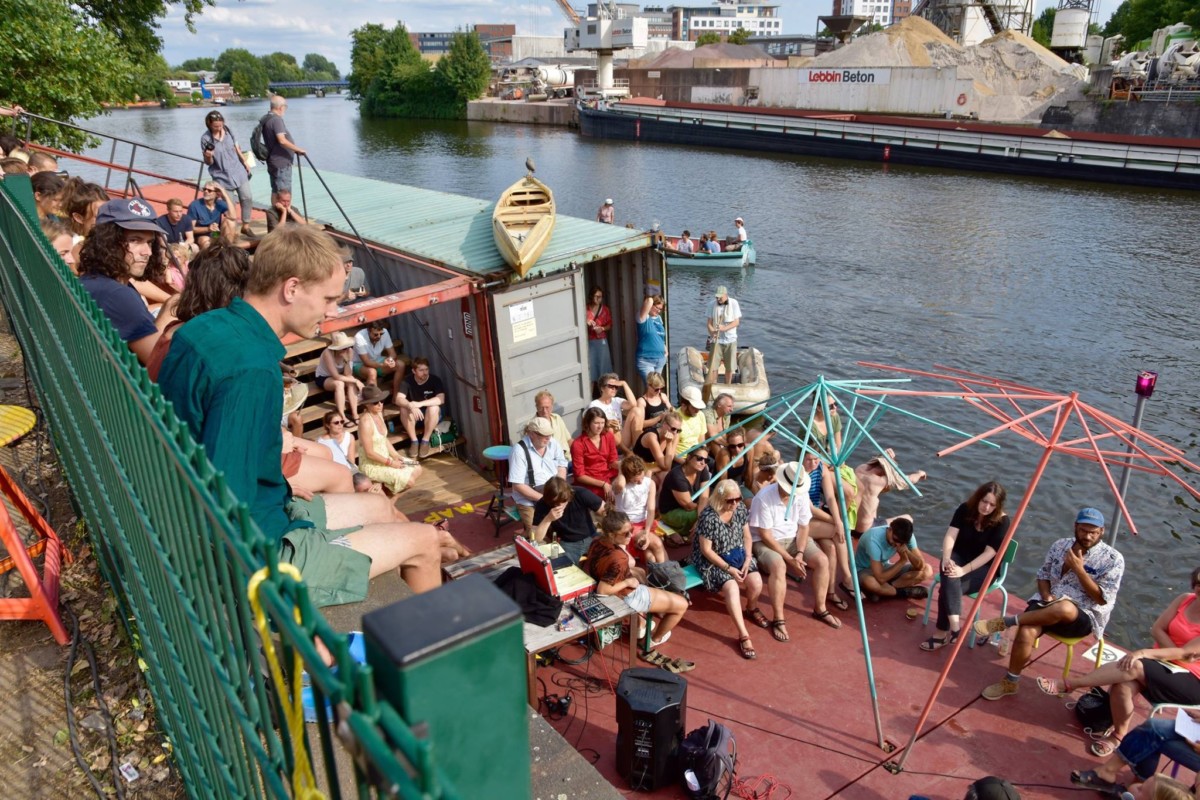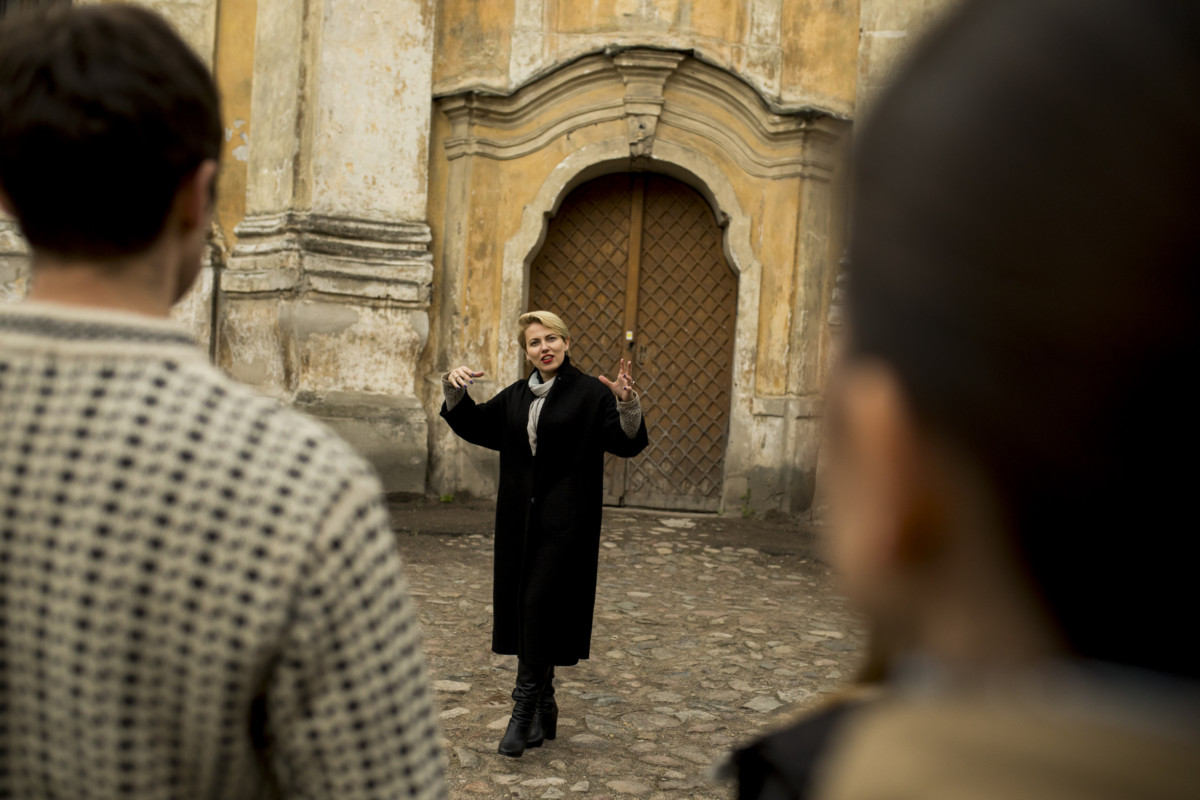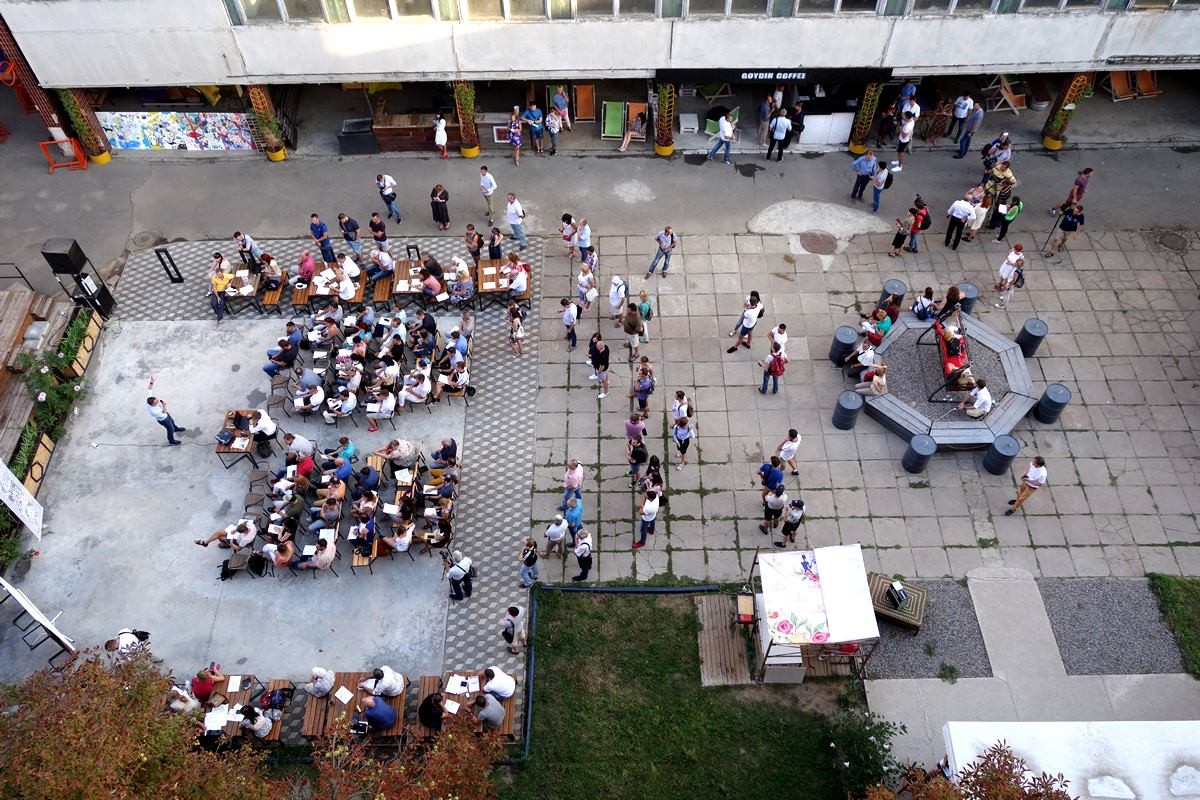Our cities look more and more similar everywhere and both capitalism and communism are to blame. Gathering spaces are disappearing—sold out, left abandoned or replaced by virtual ones—at great peril to communities. Can urban collectives reclaim old spaces for new connections and creative experimentations?
Listen to the story’s podcast:
By Sara Grossman
Urban sameness has reached epidemic levels. In city centers across Europe, the comfort of familiarity is never far out of reach. If not for the local Starbucks franchise, then for the non-chain coffee alternative—generally with its Millennial-approved, slightly edgy-industrial furniture to match. So convenient, so comforting and yet, in many ways, so bleak.
In the 20th Century, such successes of innovative Western enterprise served as proud rebukes to the tired sameness of centralized Soviet planning, in which economy and culture were orchestrated by the state, with grassroots culture having little place to thrive in the open. From the view of the East, however, the economic and cultural achievements of western Capitalism were indulgent and chaotic—indeed, does the world truly benefit from 30,000+ McDonalds, some locations just blocks away from each other?
In today’s cities, the legacies of both systems have proven unsatisfactory for local residents. In post-Soviet states, the remnants of standardized cultural infrastructure can be found in city centers across the region, with the same “traditional museums, traditional theaters and [traditional] universities,” according to one Ukrainian advocate. In more capitalistic environments, Starbucks, McDonalds and the myriad of other familiar global brands are just as expected in any chosen urban center.
Cities—whether developed in the legacy of heavy-handed central planning or shaped by global corporations vying for more and more of their market share—are suffering from a shared ill of dull uniformity. And yet, there is an even newer threat to urban autonomy: With the rise of the internet, savvy tech companies have seductively made the case that in an age of instant global connection, non-commercial space to gather is hardly important—every need for community you think you might have can be found at the click of a button. These companies have appropriated the language of “local” and “community” enough to fully redefine them. Facebook, for example, claims to “bring the world closer together,” while Airbnb “create[s] a world where anyone can belong anywhere.” Apple, meanwhile, has conceptually redesigned its stores as local “town halls”—a wholly unsubtle move “to reconfigure civic life around itself and its ideals,” according to one tech publication after the announcement.
Undoubtedly, it is easy to superficially belong anywhere when “everywhere” is fundamentally the same, devoid of any defining place-based character or complex engagement with local customs, needs, or communities.
At a time when the value of “local community” is itself under attack, collectives across Europe have begun to see the reuse of historic infrastructure for new forms of culture-making as a key strategy to maintaining unique local identity and culture. And three Actors projects working in very different urban contexts are seeking to do just that: repurposing old, abandoned spaces for new community connections and creative experimentations—elements that are critical to what makes a city a compelling and quality place to live.
Indeed, a 2010 Knight Foundation study of more than 40,000 people in cities worldwide found that the most critical factors for creating emotional bonds between people and community were not jobs or the economy, but “physical beauty, opportunities for socializing and a city’s openness to all people.”
Reflecting on these findings two years later, Urban Land Institute’s Edward T. McMahon concluded that “character is key” in driving a city’s prosperity.
“Planners spend most of their time focusing on numbers—the number of units per acre, the number of cars per hour, the number of floors per building,” McMahon wrote. “In the future, they will need to spend more time thinking about the values, customs, characteristics and quirks that make a place worth caring about.”
Unfortunately, he continued, “many communities are suffering the social and economic consequences of losing their distinctiveness.”
____
In the northern German city of Hamburg, residents are witnessing perhaps the ultimate example of how grassroots community and local culture can be swept aside for the benefit of outsiders with little connection to place.
The port city is today one of the top cities in Germany for foreign direct investment, according to fDi Magazine. And the effects are evident: Prices for existing apartments have risen more than 70% since 2009, according to a 2018 Deutsche Bank report.
Even back in 2010, however, the German Spiegel newspaper documented early anxieties around the city’s changing landscape and inhabitants. “Hamburg currently functions as a focal lens of sorts, one in which the conflicts of the coming decades are already recognizable,” wrote journalist Philipp Oehmk. “These conflicts will pit change against preservation, private property against the community and, most of all, economic interests against social considerations.”
Nearly a decade later and these conflicts are in full view with the completion of the shiny development of HafenCity, home to the city’s €789 million Elbphilharmonie, a towering glass concert hall representing one of Hamburg’s biggest investments in local culture.
And still, Hamburg advocates say, this “local culture” is not necessarily for the locals.
“In general there is a much larger focus on classical or high culture,” said Dorothee Halbrock, collaborator on projects for HALLO:, a cultural organization working at the crossroads of art and urban development. “While there is support for grassroots projects, it is really in small amounts—there is definitely a huge difference in funding.”

One Spiegel article described the HafenCity quarter as “the loneliest place in the world”—a “neighborhood planned first for investors and tourists, then for citizens.” According to Deutsche Bank, rental prices per square meter in the city center are almost double that outside the area, largely due “to elevated prices in the HafenCity quarter.”
As global investors further belly their way into prime urban property, longtime residents find themselves with little say in development decisions and at risk of being shoved aside entirely—and most at risk are the colorful people who have long made the city interesting: its artists, musicians, young people and other culture makers.
“What we want is not to help to bring it up in the common sense of city [growth] but to protect and co-develop the space, letting it live on as it is now.”
Halbrock, along with the fellow members of Actor’s Team Hamburg, is working to bridge that support for grassroots culture with Kraftwerk Bille, a former power plant along the Elbe River in Hamburg’s industrial Hammerbrook neighborhood. Together with the private company MIB Coloured Fields—the building’s owners— and the public agency Kreativgesellschaft, which supports the city’s creatives in finding space, the team is redeveloping part of the plant as a public space for culture, new forms of work and experimental co-creation. In doing so, they hope to ensure that the city remains an open and viable space for artists and other grassroots culture makers to continue contributing to Hamburg’s unique urban culture and identity.
So far, they have implemented regular cultural programming at Schaltzentrale, a neighborhood office in Kraftwerk Bille and kicked off a new project exploring new forms of work. During their annual Hallo: Festspiele festival at the power plant, they explored ways to increase access to the nearby waterfront.
Unlike some of Hamburg’s larger cultural projects, Halbrock said, the team intends to develop the space with neighbors and other locals, ensuring that it remains a cultural center truly grounded in community, even as the area around it grows and becomes more attractive to new residents.
“[Hammerbrook] is definitely an up-andcoming neighborhood,” she said. “What we want is not to help to bring it up in the common sense of city [growth] but to protect and co-develop the space, letting it live on as it is now.”
_____
Eastward across the Baltic, in a city more recently cleaved open for fevered global investment, a team of Actors is similarly seeking to “co-develop” historic infrastructure into a space for community engagement. Unlike Kraftwerk Bille, however, which sits tucked away in Hamburg’s industrial east, Vilnius’ St. Virgin Mary the Comforter Church has long sat in the center of urban life, an inconspicuous observer to the many transformations in this post-Soviet city.
Constructed in the 1600s, the church has since beared many identities: Catholic, Orthodox, Catholic again and, in Soviet times, an industrial storage space for meat and vegetables. Until recently, the church has stood empty, observing silently as the spaces nearby were bought out by private investors and closed off as public spaces.

Ten years ago, said architect and longtime Vilnius resident Zemartas Budrys, his dog could run freely through historical parts of the city. Now even he himself cannot pass through many parts as “the Old Town becomes more and more locked in [with] no strategy to serve public interests over private ones.”
Indeed, after gaining independence in 1991, Lithuania shifted rapidly from Soviet development practices—in which every city, street, square and cultural institution or program was carefully planned by the central communist government—to one in which the free market became the key influence in development. Today, just less than 30 years after independence, Vilnius’ Old City is almost unrecognizable, with historic buildings now home to standard global retailers like Zara, Mango and United Colors of Benetton.
The church is being redeveloped as a community space, addressing a lack of dialogue between city authorities and community groups.
In the August 2008 edition of Global Urban Development, Jurate Raugaliene, an architect with Vilnius’ Old Town Renewal Agency, wrote that new groups of inhabitants in the Old Town have adapted the environment to their purposes, “sometimes to the detriment of the existing historic urban context.”
“Few of the social groups residing in or basing their businesses in the Old Town have sufficient knowledge of the history, culture and heritage value of the area and fewer have the functional knowledge of conservation methodology,” Raugaliene wrote. “The need for education in the management of cultural properties has increased significantly, then, with the growth of renewal work in Vilnius Old Town and with the potential for more active resident and investor participation.”
Budrys, as part of Actors’ Team Vilnius, is seeking to foster such active participation by tackling the city’s growing lack of noncommercial shared space and urban “samification” more broadly. Working collaboratively with the Ministry of Interior and the local Catholic community, they are redeveloping the church as a community space, particularly interested in addressing what they say is a lack of dialogue between authorities and community. They’ve been opening up space for exchange towards that end, seeking to improve understanding between local police and community groups. In honor of the church’s long religious history, they have also made space for a chapel on the second floor, open for use by believers and other local residents.
Through the space co-creation process, the community now involved with the church has also identified a key topic area—human trafficking and modern slavery—as an issue for further exploration and engagement. The team, working with the Ministry of Interior, which owns the church, has held a number of research and advocacy events on this topic and hopes to ultimately engage local artists with an ongoing residency for those working on issues related to modern slavery.
“[The space] is really an enclave, there is something extraordinary in the way it functions so differently from other places around it,” Budrys said. “The city itself is very privatized— but the Old Town is to the extreme.”
As the rest of the Old City continues to give way to the wills of the free market, the redeveloped church may one day stand as a safe space for different communities to develop a comfeeling of belonging—a sign for local residents that all are welcome, not only those with something to spend.
____
While Lithuania quickly replaced the stultifying sameness of communist infrastructure with a shiny new brand of capitalistic uniformity after independence, Ukraine, another former Soviet state, has not transitioned quite as rapidly.
In the southern city of Kherson, says Olena Afanasieva, the same type of expected cultural offerings can be found as 50 years ago, with little room for other types of creative culture making. The city has “all the traditional culture institutions which remain from the Soviet times,” said Afanasieva, who is a cultural manager with the Centre of Cultural Development “Totem” in Kherson.
”In my city—in each city—you have the palace of culture and a traditional theater,” she said. “Of course you can use these spaces, but really innovative new ideas appear in creative spaces.”

The consequences of this lack of space are evident: young people continue to flood outward, seeking excitement and experimentation in places with greater possibility. More generally, the city has lost population at a rate of more than half a percent per year since Ukraine gained independence in 1991.
“Active young people leave the city because of an absence of places to realize their creative potential, innovative ideas, culture and social initiatives,” Afanasieva said.
And unlike Vilnius, the infrastructural relics of the Soviet Union and Kherson’s industrial past continue to loom large over the city. Once a hub for shipbuilding, textiles and agricultural machine production, many of these factories— some of which are located in the city center, despite their toxic ecological and health effects— now sit empty, partially used, or entirely abandoned.
“These empty spaces not only form a depressing view of Kherson for residents and tourists, but also forms a depressed economic, ecological and emotional background to the city,” Afanasieva said. “Now we don’t need large-scale production, [but the] old city infrastructure is our urban heritage, which has to also be transformed.”
Kherson is at a key moment, as the world has “become open” to Ukrainians and Kherson’s residents are seeing alternative ways that culture can be made and experienced
As a member of Actors’ Team Kherson together with a business association chairman and a city official from the culture department, Afanasieva is seeking to do just that, revitalizing a former factory into a space for culture and community interaction—all while working to preserve the history of the space and honor the city’s industrial past.
During the course of their time as an active Actors’ project, they have invited a number of artists and designers to create new works and installations within the factory, developed a lecture and exhibition space and hosted more than 50 open lectures on art and culture and, most critically, gained the active involvement of the local community, NGOs, activists and social entrepreneurs in planning activities for an art platform.
They also revitalized an abandoned lot into an active public square, which hosted more than 100 cultural and social events, particularly on urbanism and community development.
“We created the urban garden as an open public space,” Afanasieva said. “[A] new format that is the most important step for understanding the possibilities of modern urban development by the community and for the benefit of the community.”
Fundamentally, she said, Kherson is at a key moment, as the world has “become open” to Ukrainians and Kherson’s residents are seeing alternative ways that culture can be made and experienced, beyond traditional boundaries.
“That’s why we created this project—to break the gap between World of Big Possibilities and Kherson,” Afanasieva said.
_______
And the World of Big Possibilities is truly vast, filled with diverse cultural activities and compelling local identities that offer respite from the bleak sameness produced by either communist central planning or the freewheeling open market.
“Place is more than just a location on a map,” explained the urban researcher McMahon in his 2012 analysis of why “culture is key” to a prosperous city. “To foster distinctiveness, cities must plan for built environments and settlement patterns that are both uplifting and memorable and that foster a sense of belonging and stewardship by residents,” he wrote.
These projects, in Hamburg, in Vilnius and in Kherson, are steadfastly working towards that vision, not only stepping in to develop space for culture makers and artists where support is lacking, but at the most base level making their cities, their communities better places to live. No matter what bloated tech brands or other omnipresent global companies might suggest about what community “is”, nothing can replace the simple act of connecting in person, of meeting one’s neighbors and of experiencing the joys of art, culture and education together in space that was not developed for commercial use or economic gain.
“Given all this, I believe that one of the big questions for cities in the future will be: Do you want the character of your city to shape the new development?” McMahon asked, “Or do you want the new development to shape the character of the city?”
At least in these three cities, advocates are fighting to ensure the former.
